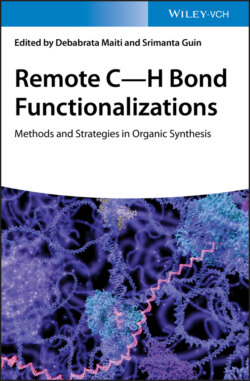Читать книгу Remote C-H Bond Functionalizations - Группа авторов - Страница 18
2.2.3.3 Phenylethylamine Derivatives
ОглавлениеIn 2015, the group of Li achieved the first meta‐C–H olefination of N‐methyl‐phenylethylamine derivatives using the 2‐cyanobenzoyl group as the CF (Scheme 2.26) [34], followed by the isolated examples of meta‐C–H olefination of tertiary phenylethylamine derivatives mentioned in Section 2.2.3.2 [33]. In presence of Pd(OAc)2 and Ac‐Gly‐OH under nitrogen atmosphere, the reaction proceeded smoothly with a broad scope of substrate, and the directing template is structurally very simple and commercially available. Moreover, to increase the potential of application of direct C–H transformations in organic synthesis, using 2‐cyanobenzoyl group as the common original directing functionality to access regiodivergent C–H activation was also demonstrated in a sequential remote‐selective C–H olefination of 2‐fluorophenylethylamine (Scheme 2.27). Notably, the first remote‐selective C–H olefination occurs with the secondary amide 67 leaving the proximal aromatic ortho‐CH bond intact in an ortho‐selective manner and proceeds with an imidamide directing group that was formed through cyclization of the 2‐cyanobenzoyl motif. The desired meta‐directing template was reconstructed with methylation by using LiHMDS as the base to afford substrate 69 after hydrogenation. Finally, the second C–H olefination of 69 led to the production of tetra‐substituted phenylethylamide 70 in a meta‐selective manner under standard reaction conditions, enabling the building of molecular complexity in a concise manner.
Scheme 2.26 meta‐C–H olefination of phenylethylamine derivatives.
Source: Modified from Li et al. [34].
Scheme 2.27 Sequential remote‐selective regiodivergent C–H olefination of 2‐fluorophenylethylamine.
